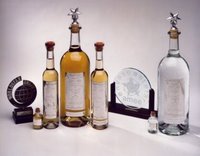
If there’s a buck to be made, does it have to be made this way?
I was sitting in a plush restaurant on the banks of upstate New York’s Mohawk River, right near the Erie Canal, an utterly gorgeous summer spot, and feeling very relaxed. Until, that is, I looked over the dinner bill for our party of four and noticed something didn’t look quite right.
Two of us had had two cocktails – Grey Goose martinis, to be precise – about an hour apart. The price was $1 more apiece for our second ones. Perhaps we’d caught the end of the happy hour discount for the first one? No. The answer wasn’t that simple.
“That’s the up charge,” the waitress explained. “We should have charged you the higher price for the first one, too, but we just missed it.”
An “up charge” usually refers to the extra cost of getting a premium brand liquor rather than what’s in the bar well. But that wasn’t what she meant.
“I mean the charge because you ordered your drink straight up. That’s $1 extra.”
You’re telling me, I carefully asked, I have to pay you extra for not putting ice in my drink, a drink that doesn’t normally come with ice anyway?
“That’s the policy,” she said with a straight face in the presence of three other witnesses.
Was this a trend I’d been missing? I’ve consumed adult beverages in a dozen countries and several dozen states and spend a lot of my time writing on the topic, but I’d never heard of such a practice. A standard martini is shaken or stirred with ice, but not poured over it. The mechanics of the thing are the same, so it’s not a matter of doing any more work preparing the drink.
In my review of the restaurant, I noted that on my next visit I’ll order a cocktail on the rocks, but also ask for a spoon so I can save $1 and scoop out the ice. Assuming, of course, they haven’t come up with a spoonage charge.
This whole thing sent me scrambling to both local sources and, via a quickie e-mail poll, to food and beverage editors around the country to get their reactions.
Among several dozen respondents locally and nationally, I found only one, Jan Norris of the Palm Beach (Fla.) Post, who was familiar with this surcharge.
“A barkeep here says, yes, it's built into the computer for $1 extra on ice-less drinks,” she said. “To quote him: ‘You're getting 1.5 extra ounces of liquor in the glass, which is essentially one shot, for $1. It's actually a good deal.’ “
However, that certainly is a minority view in my mini-survey.
Phil Vettel of the Chicago Tribune opines, “There are a couple of restaurants and bars in this area that charge 50 cents to $1.50 for ‘rocks,’ but I've NEVER heard of charging extra for leaving ice out of the glass. Outrageous! What's next, a surcharge for not slicing the bread?”
Deborah S. Hartz of the Fort Lauderdale Sun-Sentinel says, “Down here we get charged extra for a ‘rocks pour.’ Supposedly a larger pour when you order a drink on the rocks than when you order it straight up.”
Ellen Sweets, food editor of the Denver Post, added, “Lordy, just when you think things can't get any weirder in this wonderful world of ours, surprise!”
Al Sicherman of the Minneapolis Star-Tribune checked with his son, a Manhattan bartender. His reply: “My son says a martini implies straight up. (He) is puzzled as to at what point somebody would have said ‘That's an extra $1’ because, as noted, a martini is normally straight up, so it would be ‘extra’ compared with what?”
Barbara Durbin of the Oregonian in Portland echoes that latter statement, rhetorically asking, “Since when would a martini normally HAVE ice in it?”
However, there is no end to the imagination of people in business. My favorite came from Susan Nicholson, an Atlanta food writer and author of the nationally syndicated “7 Day Menu Planner.”
“I always get a Gibson straight up,” she said. “Last time a very casual restaurant charged me $6 for ‘well’ gin -- and $1.33 for the onions!”
To Dowd's Spirits Notebook latest entry.
To Dowd's Wine Notebook latest entry.
To Dowd's Brews Notebook latest entry.
Back to Dowd On Drinks home page.












